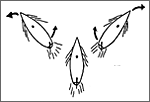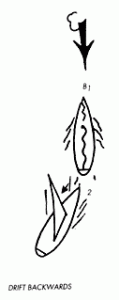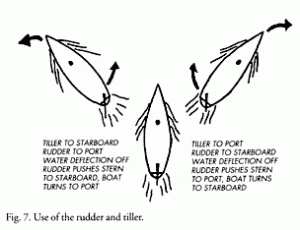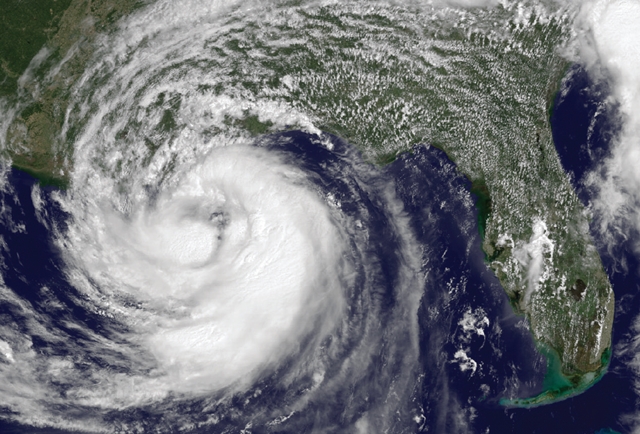Dropping the Mooring
Backing a Sail; Steering Backwards
 Once the sails are up, one would expect that leaving a mooring should be a very simple matter... just let go and you're underway. Not so. Until the boat is moving forward or backward and water is flowing past the rudder, there is no way of steering the boat with a rudder. The boat is "in irons" or " in stays," headed directly into the wind and motionless. Leaving the mooring isn't the only time this happens. Sometimes a skipper attempts to change tacks by turning the boat into the wind and sea direction. If the boat doesn't have enough forward momentum at the time, it can be stopped by a wave and loses "steerageway." When the boat is "dead in the water," the rudder is useless because there is no water flow past it to be deflected.
Once the sails are up, one would expect that leaving a mooring should be a very simple matter... just let go and you're underway. Not so. Until the boat is moving forward or backward and water is flowing past the rudder, there is no way of steering the boat with a rudder. The boat is "in irons" or " in stays," headed directly into the wind and motionless. Leaving the mooring isn't the only time this happens. Sometimes a skipper attempts to change tacks by turning the boat into the wind and sea direction. If the boat doesn't have enough forward momentum at the time, it can be stopped by a wave and loses "steerageway." When the boat is "dead in the water," the rudder is useless because there is no water flow past it to be deflected. Since the boat is headed directly into the wind when this happens, the sails are shaking, (luffing). It is necessary to fill the sails with wind in order to gain forward motion and steerageway. This happens when the boat is pointing about 45° from the wind direction. Though the sails aren't filling normally, we can force them out against the wind manually and initiate a turn away from the wind. This is called "backing" the sail. By forcing the jib out to port as in figure 1, the wind pushes the bow to starboard. As soon as the boat is heading 45° from the wind direction, we release the jib, it comes across the boat, and we trim it in on the starboard side. The boat is now in position 2 and the sails fill normally.
Since the boat is headed directly into the wind when this happens, the sails are shaking, (luffing). It is necessary to fill the sails with wind in order to gain forward motion and steerageway. This happens when the boat is pointing about 45° from the wind direction. Though the sails aren't filling normally, we can force them out against the wind manually and initiate a turn away from the wind. This is called "backing" the sail. By forcing the jib out to port as in figure 1, the wind pushes the bow to starboard. As soon as the boat is heading 45° from the wind direction, we release the jib, it comes across the boat, and we trim it in on the starboard side. The boat is now in position 2 and the sails fill normally.
The same result may be obtained by other, less effective methods. If the boat is drifting backward as in Figure 2, water is flowing past the rudder and the tiller may be used to turn the boat. Put the tiller to starboard (the reverse of what you'd do if the boat were moving forward) and the stern will steer to port, as in Figure 2. Then trim the sails, straighten the rudder, and you'll start sailing forward. I added sailing backwards to our curriculum when I observed a husband and wife "team" leaving a mooring. The wife was correctly backing the jib, but the husband was yelling at his wife because it wasn't working. Why? Because the husband wasn't aware they were drifting backwards and had the tiller hard over the wrong way, negating the efforts of his wife. I was so mad at this wrongful verbal abuse, we now teach all our students the right way to do it.
I added sailing backwards to our curriculum when I observed a husband and wife "team" leaving a mooring. The wife was correctly backing the jib, but the husband was yelling at his wife because it wasn't working. Why? Because the husband wasn't aware they were drifting backwards and had the tiller hard over the wrong way, negating the efforts of his wife. I was so mad at this wrongful verbal abuse, we now teach all our students the right way to do it.
Some small boats have no jibs. If you find yourself in irons, you must back the mainsail against the wind. Usually, depending on the location of the mast, this pushes your stern in the opposite direction, as in Figure 3. Reversing the rudder as described above will also help turn a boat that has no jib. It's very important to be able to control the boat when it is in irons. If the boat turns in the wrong direction in a crowded anchorage, it could easily hit another boat before the skipper has enough steerageway to avoid it. The standard procedure when leaving a mooring is for one crew member to untie the mooring line, but to hold onto it and even pull the boat forward if possible to obtain steerage way for the skipper, while another crew member backs the jib. When the bow is definitely swinging in the desired direction, the mooring is released.
It's very important to be able to control the boat when it is in irons. If the boat turns in the wrong direction in a crowded anchorage, it could easily hit another boat before the skipper has enough steerageway to avoid it. The standard procedure when leaving a mooring is for one crew member to untie the mooring line, but to hold onto it and even pull the boat forward if possible to obtain steerage way for the skipper, while another crew member backs the jib. When the bow is definitely swinging in the desired direction, the mooring is released.
The effectiveness of the rudder increases with the speed of the boat through the water. The boat pivots around a point near its center. Water deflected by the rudder pushes the stern in one direction and the bow turns in the other. Figure 4 shows how this works.
Reprinted from "Fundamentals of Sailing, Cruising, & Racing"
by Steve Colgate; published by W.W. Norton & Co.
Steve Colgate is the founder of Colgate Sailing Schools, with locations in Tortola BVI, Captiva Island FL, Duck Key FL, St. Petersburg FL, Chelsea Piers NY, Liberty Landing NJU and Newport RI.
Offshore Sailing Schools
16731 McGregor Blvd.
Fort Myers, Florida 33908
1-888-454-8002
239-454-1700
Fax: 239-454-1191
e-mail: sail@offshore-sailing.com
www.offshore-sailing.com












